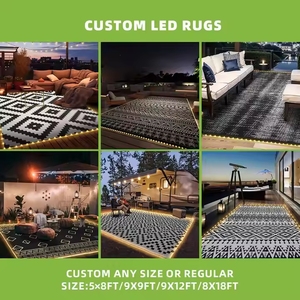
All categories
Featured selections
Trade Assurance
Buyer Central
Help Center
Get the app
Become a supplier

(1375 products available)












































Recycled plastic rugs are flooring materials made from used plastics such as bottles, containers, and wrappers. These rugs are eco-friendly options for indoor and outdoor spaces. Below are some of the notable classifications:
Recycled plastic rugs come in multiple colors, patterns, and textures. Some design aspects of these rugs include:
Designing with recycled plastic allows for sustainable and innovative solutions. These rugs can help reduce waste and pollution while providing functional and attractive flooring options. The design aspects of recycled plastic rugs show their potential for creativity and environmental benefits.
Outdoor Spaces:
Recycled plastic rugs are great for outdoor areas like patios, balconies, and decks. They can handle different weather situations, so they are suitable for outdoor furniture. Moreover, they are easy to clean, which makes them excellent for outdoor use where spills may happen often.
Dining Areas:
In indoor or outdoor dining areas, recycled plastic rugs can be placed under dining tables. They protect the floor from stains and scratches and make cleaning easy. Additionally, they provide a comfortable surface for guests to walk on.
High-Traffic Areas:
Recycled plastic rugs are suitable for hallways, entrance areas, and living rooms. They are durable and easy to maintain, making them ideal for families or businesses. Moreover, they withstand frequent use and are simple to clean, ensuring they maintain their appearance in busy spaces.
Kid’s Room:
Recycled plastic rugs are suitable for children's rooms and play areas. They can withstand spills, are easy to clean, and are non-toxic. Moreover, they provide a comfortable surface for children to play on.
Eco-Friendly Spaces:
For homes and businesses focused on sustainability, recycled plastic rugs are a good choice. They are made from recycled materials, so they help reduce environmental impact. Moreover, they are suitable for eco-friendly spaces and can be integrated into green building projects.
Event Spaces:
Recycled plastic rugs can be used in temporary event spaces, outdoor weddings, or festival areas. They are easy to transport, install, and clean, making them suitable for event flooring.
Material composition:
Recycled plastic rugs are made from various materials, including polyethylene, polypropylene, and polyester. Each material has unique properties in terms of durability, water resistance, and UV protection. For example, polyethylene is known for its high strength and impact resistance, making it suitable for heavy foot traffic areas. On the other hand, polypropylene offers excellent color retention and water resistance, making it ideal for outdoor use. Consider the materials used in the rugs and choose one that best suits the intended purpose and location.
Durability and maintenance:
Recycled plastic rugs are generally durable and easy to maintain. However, it's important to check for specific durability features, such as stain resistance and fade resistance. Additionally, consider the ease of cleaning and maintenance requirements. Some rugs may only need occasional vacuuming, while others may require specific cleaning methods. Evaluate the durability and maintenance aspects to ensure the rug will last and remain in good condition in its intended location.
Size and shape:
Choosing the right size and shape of a recycled plastic rug ensures it fits well in the intended space. Measure the area where the rug will be placed and consider the furniture layout. If the rug is for outdoor use or in larger spaces, consider rectangular or square shapes, as they offer better coverage and balance. Additionally, some rugs come in custom sizes, allowing for more flexibility. Choose a size and shape that matches the requirements to achieve visual harmony and functional practicality.
Environmental certification:
Recycled plastic rugs may have environmental certifications, such as the Global Recycled Standard (GRS) or the OEKO-TEX Standard 100. These certifications ensure that products meet specific environmental and social responsibility standards. Choosing rugs with environmental certifications can provide assurance that the product has been manufactured in an environmentally friendly manner and has a positive impact on sustainability. It also shows consumers' support for environmentally friendly products and practices.
Q1: Are outdoor rugs good with water?
A1: Recycled plastic rugs can resist water and damp conditions. Their construction does not allow water to penetrate them, hence making them mold and mildew-free. Additionally, these rugs dry up quickly when exposed to water.
Q2: Can outdoor rugs be used inside?
A2: Recycled plastic rugs can be used in any room, including living rooms, kitchens, and children's playrooms. Since they are easy to clean and maintain, putting them in areas where there are high foot traffic is ideal.
Q3: How are outdoor rugs stored in winter?
A3: When storing winter rugs, always ensure they are clean and dry to prevent mold and mildew growth. Depending on the size of the rug, users can either roll or fold the rug. After rolling or folding, users can place it in a storage bin and cover it with a plastic bag.
Q4: Can stains be removed from outdoor rugs?
A4: Most stains on outdoor rugs can be removed using mild soap and water. For stubborn stains, users can use a soft bristle brush or a carpet shampooer. Before applying any stain remover, testing it on a small, inconspicuous area of the rug is advisable to avoid damaging the color or material.